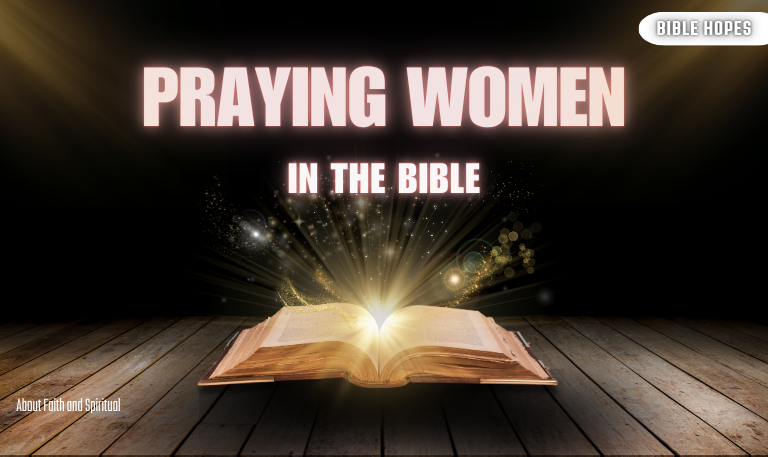Prayer has always been a vital practice in the spiritual lives of believers, serving as a direct line of communication with God. In the Bible, many women stand out not only for their faith but for their powerful, persistent prayers that shaped history and influenced the course of God’s plan. Understanding praying women in the Bible helps us appreciate the profound role women have played in the spiritual narrative and offers modern believers timeless lessons in faith, perseverance, and devotion.
This article dives deep into the lives of these remarkable women, exploring their stories, the nature of their prayers, and the lessons they teach us. Whether you seek inspiration to deepen your own prayer life or want to understand biblical prayer through the lens of women’s experiences, this comprehensive guide covers it all.
1. Understanding Prayer in the Biblical Context
What Is Prayer According to the Bible?
Prayer is a heartfelt dialogue between humanity and God — encompassing praise, thanksgiving, confession, petition, and intercession. Both the Old and New Testaments reveal prayer as an essential act of worship and trust.
The Role of Women in Biblical Prayer
Contrary to some cultural assumptions, women in the Bible frequently prayed, interceded, and even led others spiritually. Their prayers were instrumental in God’s unfolding plan and demonstrate spiritual leadership.
Read Also: God Whispers to Us in Our Pleasures
2. Notable Praying Women in the Bible: Profiles and Stories
Let’s explore some of the most influential praying women in the Bible and the impact of their faith-filled prayers.
Hannah: The Model of Persistent Prayer
Reference: 1 Samuel 1:1-28
Hannah’s story epitomizes persistent prayer and unwavering faith. Childless and deeply distressed, she prayed earnestly for a son, vowing to dedicate him to God. Her heartfelt prayer was answered with the birth of Samuel, a key prophet in Israel’s history.
Lesson: Persistent prayer with a humble heart can move mountains.
Mary, Mother of Jesus: Prayerful Obedience and Faith
Reference: Luke 1:26-56
Mary’s prayer life shines in the Magnificat — a song of praise and gratitude that reflects deep trust in God’s promises. Her acceptance of God’s plan shows prayer as a form of surrender and worship.
Lesson: Prayer is not only petition but also joyful obedience.
Anna the Prophetess: Devoted Worship and Prayer
Reference: Luke 2:36-38
Anna dedicated her life to prayer and fasting in the temple, patiently awaiting the Messiah. Her steadfast devotion symbolizes how prayer sustains faith through waiting.
Lesson: Prayer is powerful in seasons of waiting and hope.
Esther: Bold Intercessory Prayer for Her People
Reference: Book of Esther
Facing potential destruction of her people, Esther called for a three-day fast and prayer. Her courageous intercession saved the Jews and highlights prayer coupled with courageous action.
Lesson: Prayer empowers boldness and advocacy.
Deborah: Leadership and Prayer
Reference: Judges 4-5
Deborah, a prophetess and judge, combined leadership with prayerful wisdom, guiding Israel in times of crisis. Her example affirms that women’s prayers can lead nations.
Lesson: Prayer is integral to spiritual leadership.
Martha and Mary: Contrasting Approaches to Prayer and Service
Reference: Luke 10:38-42
Martha’s busy service and Mary’s focused listening to Jesus highlight different expressions of faith. Mary’s attentiveness reflects a prayerful heart tuned to God’s presence.
Lesson: Prayerful stillness is as important as active service.
The Persistent Widow: Teaching on Prayer and Perseverance
Reference: Luke 18:1-8
Jesus shares the parable of the persistent widow to encourage perseverance in prayer, illustrating that persistent faith is always heard.
Lesson: Never lose heart in prayer.
3. Characteristics of Praying Women in Scripture
Across these stories, certain qualities emerge repeatedly in biblical praying women:
Faith and Trust: They believe God will answer in His timing.
Persistence: They continue praying despite delays or obstacles.
Humility: They approach God with reverence and repentance.
Boldness: They intercede courageously for others.
Worship: Their prayers overflow with praise and thanksgiving.
4. Types of Prayer Practiced by Women in the Bible
Women in the Bible engaged in diverse forms of prayer, each serving a distinct spiritual purpose:
| Type of Prayer | Biblical Examples | Purpose |
|---|---|---|
| Intercessory Prayer | Esther’s prayer for her people (Esther 4) | Praying on behalf of others |
| Prayer of Petition | Hannah’s plea for a child (1 Samuel 1) | Asking God for needs |
| Prayer of Thanksgiving | Mary’s Magnificat (Luke 1:46-55) | Praising God and showing gratitude |
| Prayer of Repentance | Anna’s devout prayers (Luke 2:37) | Confessing and seeking forgiveness |
| Silent/Vocal Prayer | Various instances, including Mary’s quiet listening | Personal reflection and communication |
5. The Impact of Women’s Prayer in Biblical History
Women’s prayers were not private rituals but powerful forces that changed destinies:
Hannah’s prayer led to the birth of Samuel, Israel’s prophet and judge.
Esther’s intercession saved the Jewish nation from annihilation.
Anna’s faithful prayers affirmed Jesus’ identity as the Messiah.
These examples emphasize prayer’s ability to influence history and fulfill God’s purpose.
6. Lessons Modern Women Can Learn from Biblical Praying Women
Develop Consistency: Make prayer a daily habit as Anna did.
Be Persistent: Keep praying even when answers seem delayed.
Pray Boldly: Like Esther, stand in faith for others.
Combine Prayer with Action: Prayer motivates courageous deeds.
Embrace Stillness: Like Mary, cultivate moments of listening.
7. Common Misconceptions About Women’s Role in Prayer
Despite cultural assumptions, the Bible affirms women’s active spiritual roles. Misinterpretations about women’s silence or submission often ignore scriptural examples of women praying publicly, prophesying, and leading spiritually.
8. How to Pray Like Biblical Women: Practical Guidance
Set Aside Dedicated Time: Follow Anna’s example of devotion.
Use Scripture-Based Prayers: Adapt prayers like Hannah’s or Mary’s Magnificat.
Pray with Faith and Expectation: Believe in God’s response.
Include Others in Prayer: Practice intercession regularly.
Practice Thanksgiving and Praise: Balance requests with gratitude.
Read Also: Who Is John Calvin
9. Prayers of Women in the Bible: Examples to Reflect On
Hannah’s Prayer of Dedication (1 Samuel 2:1-10)
A profound prayer thanking God for His sovereignty and justice.
Mary’s Magnificat (Luke 1:46-55)
A poetic song praising God’s mercy and power.
Anna’s Prayer and Fasting (Luke 2:36-38)
Demonstrates commitment through prayer and fasting.
Esther’s Fasting and Prayer (Esther 4:15-17)
A call to community prayer before courageous action.
10. The Role of Prayer in Women’s Spiritual Leadership
Women like Deborah and Anna show that prayer accompanies spiritual authority and leadership, helping discern God’s will and guiding others.
11. Praying Women in Different Biblical Traditions
The Old Testament depicts women praying in public and private worship; the New Testament continues this with figures like Mary and Anna, reflecting evolving roles but consistent faith.
12. Biblical Prayer and Its Relevance for Women Today
Ancient prayers emphasize timeless principles: faith, persistence, and praise. Modern believers can draw strength and structure from these prayers for their own spiritual growth.
Praying Women in the Bible FAQs
Q1: Who are some praying women mentioned in the Bible?
A1: Notable praying women include Hannah, Mary (mother of Jesus), Anna the prophetess, Esther, Deborah, and the persistent widow.
Q2: What can we learn from Hannah’s prayer?
A2: Hannah teaches persistence in prayer and dedicating answered prayers back to God.
Q3: How did Esther use prayer to save her people?
A3: Esther called for a community fast and prayer before approaching the king with courage, showing prayer’s power in advocacy.
Q4: Did Jesus teach women how to pray?
A4: Jesus taught prayer universally, with examples like Mary Magdalene and other women who prayed alongside men.
Q5: Can women pray out loud in church according to the Bible?
A5: Scripture records women praying and prophesying publicly, supporting their active prayer role.
Q6: What types of prayers did women use in the Bible?
A6: Women prayed intercessory prayers, petitions, thanksgivings, confessions, and engaged in fasting.
Q7: How can I develop a prayer life like biblical women?
A7: Establish daily prayer habits, be persistent, use scripture-based prayers, and pray both silently and aloud.
Q8: Are there prayers written by women in the Bible?
A8: Yes, examples include Hannah’s prayer and Mary’s Magnificat.
Q9: Why is prayer important for women today?
A9: Prayer connects women to God’s guidance, strength, and community, empowering them spiritually.
Q10: How did Anna’s prayer reflect her faith and patience?
A10: Anna’s lifelong prayer and fasting showed unwavering hope and devotion during waiting.
Conclusion
The praying women in the Bible offer timeless lessons of faith, courage, and perseverance that continue to inspire believers today. Their prayers shaped history, expressed deep trust in God, and demonstrated the power of heartfelt communication with the divine. By learning from their examples and embracing a committed prayer life, modern women can deepen their relationship with God and influence their communities with boldness and grace.



![15 Pink Bible Verses | Discover Meaning, Love [2025 Guide] 5 15-Pink-Bible-Verses-Discover-Meaning,-Love-[2025-Guide]](https://biblehopes.com/wp-content/uploads/2025/05/15-Pink-Bible-Verses-Discover-Meaning-Love-2025-Guide.png)